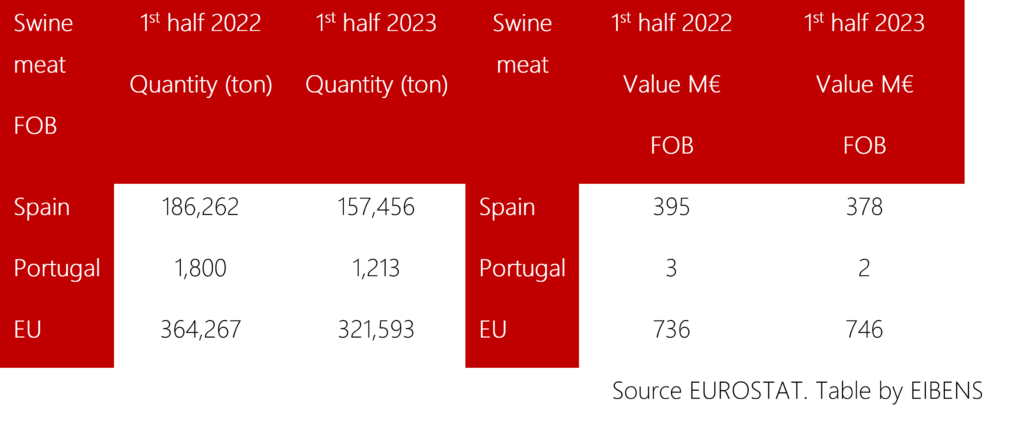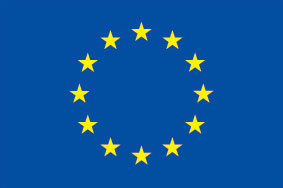The prevailing consensus among external observers [1] suggests that China will likely need to increase its pork imports, despite the month-on-month decline. By value, swine meat imports increased by 27% from January to August compared with the same period last year.
The decrease in month-on-month imports is attributed [2] to the narrowing price gap between imported and domestic pork. However, analysts express confidence that as domestic pork prices rebound and suppliers in other countries soften their prices for exports to China, the nation will likely resume its trend of increasing swine meat imports.
The EU exports of swine meat by volume to China in the first half of 2023 experienced a drop of -12% while there was a 1% increase in value. Spain and Portugal experienced a drop in volume respectively as compared to the same period of last year of -15% (Spain) and -33% (Portugal).
The drop in volume of exports from the EU to China follows a current increase in price per kilogram. This price increase is consistent across EU swine meat exporters, with the EU experiencing a 15% price hike, while Spain saw a 13% increase and Portugal recorded a 17% rise. This resulted in a drop in volume of -27% for the exports of EU swine meat to China.
 As for offal, there´s a drop of imports by volume of 3% from the EU caused by a decrease of 22% from Denmark while the rest of EU stayed flat or increased its offal exports. Regarding the two participants in the campaign, China increased its offal imports by volume from Portugal 21% while the increase from Spain was of 1%, although the latter comes from a much larger base.
As for offal, there´s a drop of imports by volume of 3% from the EU caused by a decrease of 22% from Denmark while the rest of EU stayed flat or increased its offal exports. Regarding the two participants in the campaign, China increased its offal imports by volume from Portugal 21% while the increase from Spain was of 1%, although the latter comes from a much larger base.
[1] Genesus Global Market Report (envoke.com)
[2] Viewpoint | Hogs can still be expected in the future Market or delayed and highly restricted _ Oriental Wealth Network (eastmoney.com)





[…] clindamicina 150mg capsules[…]
clindamicina 150mg capsules
does fluoxetine give you energy
does fluoxetine give you energy
what happens when you stop taking zoloft
what happens when you stop taking zoloft
mma metronidazole
mma metronidazole
taking cymbalta while pregnant
taking cymbalta while pregnant
can dogs take keflex for ear infection
can dogs take keflex for ear infection
difference between dog and human cephalexin
difference between dog and human cephalexin
bupropion gabapentin
bupropion gabapentin
does lexapro make you lose weight
does lexapro make you lose weight
generic viagra in us
generic viagra in us
how to prenounce escitalopram
how to prenounce escitalopram
cymbalta (duloxetine)
cymbalta (duloxetine)
cephalexin capsules
cephalexin capsules
allergic reaction to ciprofloxacin hcl
allergic reaction to ciprofloxacin hcl
bactrim dosing for uti uptodate
bactrim dosing for uti uptodate
how long does bactrim stay in your system after the last pill
how long does bactrim stay in your system after the last pill
amoxicillin 875 mg
amoxicillin 875 mg
neurontin tablet strength
neurontin tablet strength
augmentin 875 mg
augmentin 875 mg
diclofenac sodium topical gel 1 reviews
diclofenac sodium topical gel 1 reviews
mylan ezetimibe
mylan ezetimibe
hydrochlorothiazide and flomax
hydrochlorothiazide and flomax
ddavp in liver failure
ddavp in liver failure
brand name for citalopram
brand name for citalopram
cozaar price
cozaar price
depakote er 500mg
depakote er 500mg
verapamil vs diltiazem
verapamil vs diltiazem
vitamin d and contrave
vitamin d and contrave
flexeril overdose
flexeril overdose
effexor xr withdrawal
effexor xr withdrawal
aripiprazole moa
aripiprazole moa
allopurinol 100mg side effects
allopurinol 100mg side effects
amitriptyline for dogs
amitriptyline for dogs
aspirin nsaid
aspirin nsaid
augmentin is in which class of drugs
augmentin is in which class of drugs
bupropion hcl sr 150 mg
bupropion hcl sr 150 mg
ashwagandha while breastfeeding
ashwagandha while breastfeeding
celecoxib 200 mg used for
celecoxib 200 mg used for
robaxin vs baclofen
robaxin vs baclofen
protonix rob holland
protonix rob holland
pharmacodynamie actos
pharmacodynamie actos
repaglinide category
repaglinide category
constipation on semaglutide
constipation on semaglutide
robaxin generic name
robaxin generic name
remeron versus effexor
remeron versus effexor
abilify and tardive dyskinesia
abilify and tardive dyskinesia
acarbose liver
acarbose liver
sitagliptin 50 mg uses
sitagliptin 50 mg uses
how long does it take for tizanidine to work
how long does it take for tizanidine to work
ivermectin generic
ivermectin generic
how much potassium in spironolactone
how much potassium in spironolactone
tamsulosin hcl 0.4 mg cap side effects
tamsulosin hcl 0.4 mg cap side effects
synthroid nodules
synthroid nodules
pristiq vs venlafaxine
pristiq vs venlafaxine
voltaren gel 1% walmart
voltaren gel 1% walmart
cialis online pills
cialis online pills
is 60 mg of sildenafil too much
is 60 mg of sildenafil too much
buy levitra
buy levitra
levitra online medicine
levitra online medicine
overnight pharmacy tramadol
overnight pharmacy tramadol
how much does cialis cost at the pharmacy
how much does cialis cost at the pharmacy
goodrx sildenafil reviews
goodrx sildenafil reviews
cheapest cialis tadalafil 20 mg
cheapest cialis tadalafil 20 mg
tadalafil e20 pill
tadalafil e20 pill
best liquid tadalafil 2018
best liquid tadalafil 2018
vardenafil pulmonary hypertension
vardenafil pulmonary hypertension
stromectol ivermectin 3 mg
stromectol ivermectin 3 mg
auvitra vardenafil tablets
auvitra vardenafil tablets
buy viagra pills canada
buy viagra pills canada
stromectol covid 19
stromectol covid 19
cost of ivermectin pill
cost of ivermectin pill
cost of ivermectin cream
cost of ivermectin cream
ivermectin 6 tablet
ivermectin 6 tablet
30 mg sildenafil chewable
30 mg sildenafil chewable
stromectol ivermectin buy
stromectol ivermectin buy
gabapentin for dogs: dosage
gabapentin for dogs: dosage
will metronidazole treat uti
will metronidazole treat uti
keflex allergy
keflex allergy
how long does it take for trazodone to work
how long does it take for trazodone to work
side effects from lisinopril
side effects from lisinopril
is tamoxifen a chemo drug
is tamoxifen a chemo drug
can you take benadryl with prednisone
can you take benadryl with prednisone
valacyclovir dosage for cold sore
valacyclovir dosage for cold sore
does cephalexin treat gonorrhea and chlamydia
does cephalexin treat gonorrhea and chlamydia
ciprofloxacin and alcohol affect
ciprofloxacin and alcohol affect
can lyrica cause weight gain
can lyrica cause weight gain
provigil pros cons
provigil pros cons
doxycycline for syphilis
doxycycline for syphilis
amoxicillin during pregnancy
amoxicillin during pregnancy
can i take an extra metformin if my sugar is high
can i take an extra metformin if my sugar is high
tamoxifen online
tamoxifen online
levitra now online
levitra now online
pharmacy online
pharmacy online
vardenafil 20mg online
vardenafil 20mg online
can you take tadalafil and sildenafil together
can you take tadalafil and sildenafil together
female viagra pill
female viagra pill
how often can you take sildenafil
how often can you take sildenafil
how long does 100 mg sildenafil last
how long does 100 mg sildenafil last
sildenafil citrate 100mg tab
sildenafil citrate 100mg tab
sildenafil 50
sildenafil 50
sildenafil alcohol
sildenafil alcohol
buying generic levitra online
buying generic levitra online
how long does cialis last
how long does cialis last
plavix pharmacy assistance
plavix pharmacy assistance
levitra without prescription
levitra without prescription
what is tadalafil generic for
what is tadalafil generic for
viagra vs levitra
viagra vs levitra
will tadalafil lower blood pressure
will tadalafil lower blood pressure
cialis tesco pharmacy
cialis tesco pharmacy
sildenafil 50mg tablets
sildenafil 50mg tablets
levitra 40 mg reviews
levitra 40 mg reviews
indocin online pharmacy
indocin online pharmacy
reputable online pharmacy no prescription
reputable online pharmacy no prescription
sildenafil 50 mg price at walmart
sildenafil 50 mg price at walmart
cialis heart benefits
cialis heart benefits
proscar inhouse pharmacy
proscar inhouse pharmacy
sildenafil 20 mg not working
sildenafil 20 mg not working
vardenafil for stamina reddit
vardenafil for stamina reddit
tadalafil lower blood pressure
tadalafil lower blood pressure
viagra prices pharmacy
viagra prices pharmacy
bay rx pharmacy
bay rx pharmacy
what happens if a woman takes tadalafil
what happens if a woman takes tadalafil
pakistan pharmacy valium
pakistan pharmacy valium
celebrex pharmacy coupon
celebrex pharmacy coupon
tadalafil 5mg daily
tadalafil 5mg daily
ed drug vardenafil levitra
ed drug vardenafil levitra
tadalafil and grapefruit
tadalafil and grapefruit
anthem online pharmacy
anthem online pharmacy
can you take mucinex with ibuprofen
can you take mucinex with ibuprofen
do you have to take celebrex with food
do you have to take celebrex with food
celecoxib fiebre
celecoxib fiebre
alcohol and sulfasalazine
alcohol and sulfasalazine
neurontin off label uses
neurontin off label uses
carbamazepine effects and side effects
carbamazepine effects and side effects
can i take motrin with acyclovir
can i take motrin with acyclovir
gabapentin mushrooms
gabapentin mushrooms
tegretol dolore neuropatico
tegretol dolore neuropatico
etodolac pi
etodolac pi
can imitrex cause high blood pressure
can imitrex cause high blood pressure
where can i buy generic pyridostigmine pills
where can i buy generic pyridostigmine pills
mestinon alcohol interaction
mestinon alcohol interaction
elavil detox
elavil detox
diclofenac 1%
diclofenac 1%
indomethacin oxycodone
indomethacin oxycodone
amitriptyline anxiety
amitriptyline anxiety
long term use of mebeverine hydrochloride
long term use of mebeverine hydrochloride
cilostazol tab 100mg
cilostazol tab 100mg
purchase sumatriptan online
purchase sumatriptan online
donde comprar lioresal
donde comprar lioresal
imdur 30mg tablet
imdur 30mg tablet
rizatriptan benzoate polymorphism
rizatriptan benzoate polymorphism
order mobic
order mobic
imuran and eye problems
imuran and eye problems
half life of maxalt
half life of maxalt
melosteral meloxicam 15 mg
melosteral meloxicam 15 mg
how fast does azathioprine work
how fast does azathioprine work
piroxicam emagrece
piroxicam emagrece
impianto pompa di baclofen
impianto pompa di baclofen
cyproheptadine and sertraline
cyproheptadine and sertraline
lifestyle sports opening hours artane
lifestyle sports opening hours artane
can you get ketorolac tablets
can you get ketorolac tablets
can i order toradol price
can i order toradol price
tizanidine and nursing
tizanidine and nursing
zanaflex addiction symptoms
zanaflex addiction symptoms
periactin pagine sanitarie
periactin pagine sanitarie